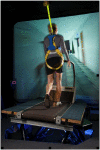Using low levels of stochastic vestibular stimulation to improve locomotor stability
- PMID: 26347619
- PMCID: PMC4547107
- DOI: 10.3389/fnsys.2015.00117
Using low levels of stochastic vestibular stimulation to improve locomotor stability
Abstract
Low levels of bipolar binaural white noise based imperceptible stochastic electrical stimulation to the vestibular system (stochastic vestibular stimulation, SVS) have been shown to improve stability during balance tasks in normal, healthy subjects by facilitating enhanced information transfer using stochastic resonance (SR) principles. We hypothesize that detection of time-critical sub-threshold sensory signals using low levels of bipolar binaural SVS based on SR principles will help improve stability of walking during support surface perturbations. In the current study 13 healthy subjects were exposed to short continuous support surface perturbations for 60 s while walking on a treadmill and simultaneously viewing perceptually matched linear optic flow. Low levels of bipolar binaural white noise based SVS were applied to the vestibular organs. Multiple trials of the treadmill locomotion test were performed with stimulation current levels varying in the range of 0-1500 μA, randomized across trials. The results show that subjects significantly improved their walking stability during support surface perturbations at stimulation levels with peak amplitude predominantly in the range of 100-500 μA consistent with the SR phenomenon. Additionally, objective perceptual motion thresholds were measured separately as estimates of internal noise while subjects sat on a chair with their eyes closed and received 1 Hz bipolar binaural sinusoidal electrical stimuli. The optimal improvement in walking stability was achieved on average with peak stimulation amplitudes of approximately 35% of perceptual motion threshold. This study shows the effectiveness of using low imperceptible levels of SVS to improve dynamic stability during walking on a laterally oscillating treadmill via the SR phenomenon.
Keywords: balance control; body motion threshold; perceptual motion threshold; stochastic electrical stimulation; stochastic resonance; vestibular stimulation.
Figures




Similar articles
-
Using Low Levels of Stochastic Vestibular Stimulation to Improve Balance Function.PLoS One. 2015 Aug 21;10(8):e0136335. doi: 10.1371/journal.pone.0136335. eCollection 2015. PLoS One. 2015. PMID: 26295807 Free PMC article.
-
Improving balance function using vestibular stochastic resonance: optimizing stimulus characteristics.Exp Brain Res. 2011 Apr;210(2):303-12. doi: 10.1007/s00221-011-2633-z. Epub 2011 Mar 26. Exp Brain Res. 2011. PMID: 21442221
-
Efficacy of Stochastic Vestibular Stimulation to Improve Locomotor Performance During Adaptation to Visuomotor and Somatosensory Distortion.Front Physiol. 2018 Mar 29;9:301. doi: 10.3389/fphys.2018.00301. eCollection 2018. Front Physiol. 2018. PMID: 29651250 Free PMC article.
-
Noise and vestibular perception of passive self-motion.Front Neurol. 2023 Apr 26;14:1159242. doi: 10.3389/fneur.2023.1159242. eCollection 2023. Front Neurol. 2023. PMID: 37181550 Free PMC article. Review.
-
Noisy galvanic vestibular stimulation: an emerging treatment option for bilateral vestibulopathy.J Neurol. 2017 Oct;264(Suppl 1):81-86. doi: 10.1007/s00415-017-8481-4. Epub 2017 Apr 8. J Neurol. 2017. PMID: 28391373 Review.
Cited by
-
Investigation on the effect of noisy galvanic vestibular stimulation on fine motor skills during a visuomotor task in healthy participants.PLoS One. 2019 May 2;14(5):e0216214. doi: 10.1371/journal.pone.0216214. eCollection 2019. PLoS One. 2019. PMID: 31048906 Free PMC article.
-
Effect of noisy galvanic vestibular stimulation on dynamic posture sway under visual deprivation in patients with bilateral vestibular hypofunction.Sci Rep. 2021 Feb 19;11(1):4229. doi: 10.1038/s41598-021-83206-z. Sci Rep. 2021. PMID: 33608568 Free PMC article.
-
Stochastic resonance improves visuomotor temporal integration in healthy young adults.PLoS One. 2018 Dec 14;13(12):e0209382. doi: 10.1371/journal.pone.0209382. eCollection 2018. PLoS One. 2018. PMID: 30550570 Free PMC article.
-
Electrical Vestibular Stimulation in Humans: A Narrative Review.Audiol Neurootol. 2020;25(1-2):6-24. doi: 10.1159/000502407. Epub 2019 Sep 18. Audiol Neurootol. 2020. PMID: 31533097 Free PMC article. Review.
-
Noisy Galvanic Stimulation Improves Roll-Tilt Vestibular Perception in Healthy Subjects.Front Neurol. 2018 Mar 1;9:83. doi: 10.3389/fneur.2018.00083. eCollection 2018. Front Neurol. 2018. PMID: 29545766 Free PMC article.
References
-
- Aihara T., Kitajo K., Nozaki D., Yamamoto Y. (2010). How does stochastic resonance work within the human brain? – Psychophysics of internal and external noise. Chem. Phys. 375 616–624. 10.1016/j.chemphys.2010.04.027 - DOI
LinkOut - more resources
Full Text Sources
Other Literature Sources
Research Materials

